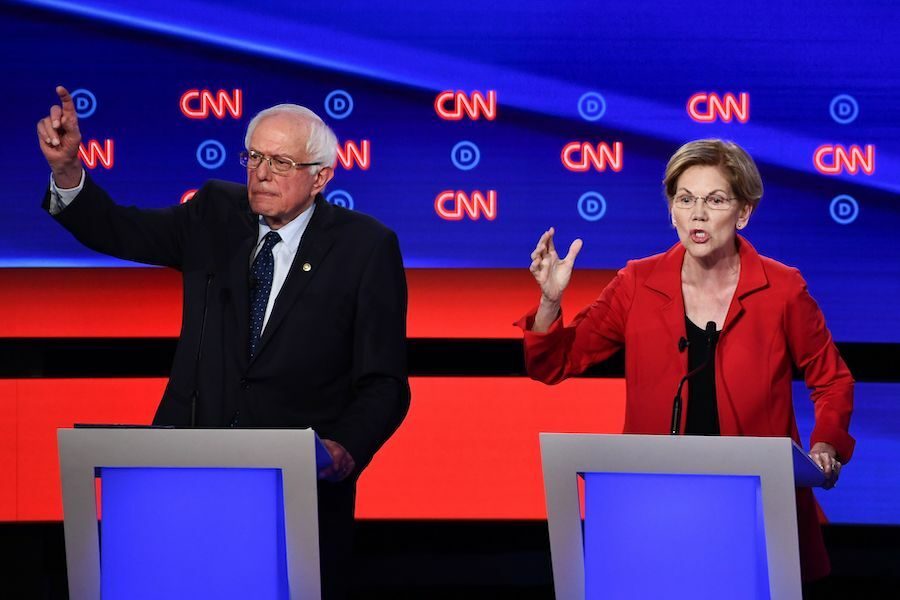
This article first appeared in Working-Class Perspectives.
Despite their general agreement on specific issues, the two most left-wing candidates for the 2020 Democratic Party nomination, Senators Bernie Sanders and Elizabeth Warren, have embraced different ideological markers. Sanders calls himself a “democratic socialist” and his near-miss 2016 primary campaign against Hillary Clinton helped spike the ranks of the Democratic Socialists of America (though he is not formally a member) to upwards of 50,000 members, including firebrand Representative Alexandria Ocasio-Cortez. Warren calls herself a “capitalist to my bones,” but one who recognizes that “markets need rules.” Despite this distinction, both advocate for a single-payer (or socialized) health insurance system, stronger labor unions, a Green New Deal, $15 an hour minimum wage, free public college tuition, and extended childcare and family leave policies, not to mention sweeping immigration reform and gun control legislation.
As Warren demonstrates, one obviously does not need to don the “socialist” mantle to compete for the affections of what Paul Wellstone once called the “democratic wing of the Democratic Party.” So why has the term “socialist” acquired a mass following among many who, before the past few years, would have called themselves “progressive,” “left-liberal,” or “radical democrat”? After all, as recently as the late-1990s, writer George Packer described how his dispirited encounter with the DSA “acquainted me with the pathos of left-wing activism in twilight. It was marginal, pedestrian work, based on the eternal postponement of gratification…Sometimes, at a forum or board meeting, I would look around at the dozen or souls who had ventured out into the cold on a weeknight and wonder what made us do it? Why did we spend our lives on this stuff?”
Twenty years later, the program that DSA founder Michael Harrington called the “left wing of the possible” has become a hot ticket. So how is it that an invocation of “socialism,” or even near-socialism in Warren’s case, can suddenly stir such fervor?
For many, the 2008 economic collapse exposed the dangers of global capitalism in its neoliberal, deregulatory phase for working people. The Democratic Party, even under Obama, had no answers—other than more free trade agreements—to the continuing slide of working-class incomes. That set the table for Sanders’s surprise showing in the 2016 primaries, which also built on the energy of the Occupy Wall Street movement of 2011. The same deep-set frustrations, alas, also helped fuel Trump’s victory. While the president’s open racism, scapegoating of immigrants, and flagrantly unethical behavior in office now provide sufficient grist for some Democrats to seek a moderate, arguably “more electable” candidate, progressives draw a different lesson from Trump’s ‘faux-populist’ appeals to white working-class voters. Both Warren and Sanders argue that only a program that addresses the structural inequality of wealth and power across race and class in American life can rally a convincing majority behind the Democratic Party.
While their goals are similar, Warren and Sanders draw on overlapping yet distinct traditions of American radicalism. Warren might be called a populist-progressive after the two major reform movements of the (first) Gilded Age. Like the populists (farmers and workers arrayed in the People’s Party of the 1890s) who attacked the “monopoly power” associated with banks and railroads, Warren identifies the political influence of big business as the source of “corruption” undermining American democracy. Her remedy for the structural inequalities built into corporate capitalism relies heavily on government “regulation,” a tool more favored by the middle-class progressives who followed the populists. From mandating worker representation on corporate boards to limiting lobbying and corporate influence over federal agencies, through her trademark “wealth tax” on ultra-millionaires, Warren’s proposals not only reverse the deregulatory push that has dominated our politics since the 1980s but recall in vision and scope nothing so much as Teddy Roosevelt’s quixotic New Nationalist campaign of 1912 for federal stewardship of the private marketplace.
Sanders emerges from the democratic-socialist tradition, rooted in the great democratic uprisings of 1848 and the socialist revolutionary creed of Karl Marx and Frederick Engels that spread gradually among working-class ranks across Europe and was first institutionalized in Germany’s Social-Democratic Party in the 1890s. The socialist critique always stressed class injustice rather than the foibles or corruption of individual malefactors. Although militarized class struggle and even a violent seizure of power still found adherents in an authoritarian backwater like Russia (where the Bolsheviks triumphed in 1917) or amidst the most marginalized of workers (as in the vision of the American IWW), by the beginning of the twentieth century, for most socialists — including the American icon Eugene V. Debs—“revolution” meant a political victory starting at the ballot box and then extending to the ‘socialization’ (or nationalization) of the major means of production. While failing to advance much on their structural demands, Debs’s pre-World War I followers enjoyed some success at the municipal level (as did Sanders in Burlington, Vermont). In Milwaukee, for example, socialists presided over a graft-free administration that gave city workers the eight-hour day, expanded public education, and sponsored free concerts in a new ring of public parks. Between war-time repression and the decline of craft unions, however, the American movement shriveled to little more than a moral protest.
By the mid-twentieth century, Western European socialism embraced a ‘reform capitalism,’ buttressed by Keynesian fiscal policy and a strong labor movement, with wealth generously redistributed via tax, health, and welfare policies as well as free higher education. “Social democracy”, a kind of cross between New Deal-style welfarism and state-centered technocratic planning, became the main left alternative across Europe. Yet the movement did not inspire an American counterpart. Except among some militants in the civil rights, feminist, and subsequent new social movements, socialism, in both thought and deed, all but disappeared as a force in American public life.
So it is telling that when Sanders explained what he meant by socialism in a June 2019 talk at The George Washington University, he chose not to revive its early twentieth-century glory days. Instead, he linked its meaning with New Deal liberalism. “If there was ever a moment when we needed a new vision to bring our people together in the fight for justice, decency, and human dignity, this is that time,” the Vermont senator said. “[We] must take up the unfinished business of the New Deal and carry it to completion.” Picking up on the “second Bill of Rights” that Franklin Delano Roosevelt had proposed in 1944, Sanders emphasized every American’s right to a living wage, health care, education, affordable housing, a clean environment, and a secure retirement. “We must recognize,” he concluded, “that in the 21st century, in the wealthiest country in the history of the world, economic rights are human rights. That is what I mean by democratic socialism.”
While they draw on different historical roots, Warren and Sanders offer remarkably similar platforms. Both are keepers of a progressive reform flame that went out in a political surrender to deregulation, bipartisanship, and the exercise of military might abroad. Warren’s “capitalism” will likely appeal to as few big capitalists today as did populism and progressivism to the likes of Standard Oil at the turn of the twentieth century. Sanders isn’t proposing Debsian socialism but rather a version of the New Deal re-outfitted for new life.
So will voters go for Bernie Sander’s democratic socialism or Elizabeth Warren’s democratized capitalism? The difference is likely more in the wrapping than the contents. To switch metaphors, both contestants are fishing in the same waters with different lures. In either case, progressives will learn soon enough whether they joined another campaign that got away.







